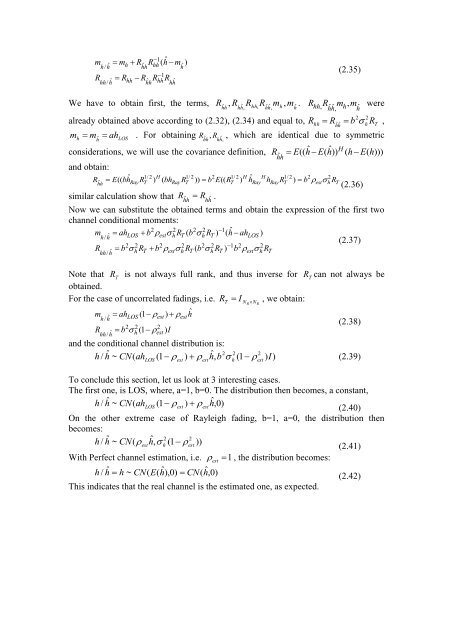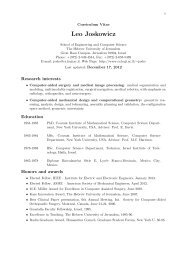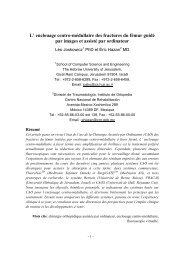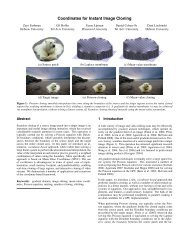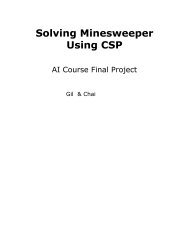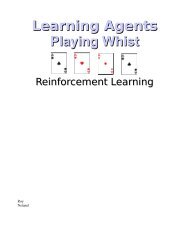TEL AVIV UNIVERSITY Gaddi Blumrosen
TEL AVIV UNIVERSITY Gaddi Blumrosen
TEL AVIV UNIVERSITY Gaddi Blumrosen
Create successful ePaper yourself
Turn your PDF publications into a flip-book with our unique Google optimized e-Paper software.
m m R R ( hˆ m )<br />
ˆ <br />
h/ h h <br />
hh ˆ<br />
1<br />
hh <br />
hˆ<br />
/ ˆ <br />
hh h hh <br />
hh ˆ<br />
1<br />
hh hhˆ<br />
R R R R R<br />
(2.35)<br />
We have to obtain first, the terms, R R R m , m . R R m , m were<br />
2 2<br />
already obtained above according to (2.32), (2.34) and equal to, R R b R ,<br />
m <br />
. For obtaining R , R , which are identical due to symmetric<br />
h m ah hˆ<br />
LOS<br />
hh ˆ hhˆ,<br />
hh ˆ<br />
similar calculation show that R R .<br />
Rhˆ , h hhˆ<br />
, hh,<br />
hˆ<br />
hˆ<br />
, h hˆ<br />
hh, hh ˆ ˆ, h hˆ<br />
(2.36)<br />
Now we can substitute the obtained terms and obtain the expression of the first two<br />
channel conditional moments:<br />
2 2 2 2 1<br />
m<br />
/ ˆ ah ˆ<br />
LOS b est hRT( b hRT)<br />
( h ahLOS<br />
)<br />
hh<br />
(2.37)<br />
2 2 2 2 2 2 1<br />
2 2<br />
R bRbR( b R ) b R<br />
Note that RT is not always full rank, and thus inverse for RT<br />
can not always be<br />
obtained.<br />
For the case of uncorrelated fadings, i.e. I , we obtain:<br />
(2.38)<br />
(2.39)<br />
To conclude this section, let us look at 3 interesting cases.<br />
The first one, is LOS, where, a=1, b=0. The distribution then becomes, a constant,<br />
h / hˆ<br />
~ CN(<br />
ah<br />
ˆ<br />
LOS ( 1<br />
est ) est<br />
h,<br />
0)<br />
(2.40)<br />
On the other extreme case of Rayleigh fading, b=1, a=0, the distribution then<br />
becomes:<br />
ˆ ˆ 2 2<br />
/ ~ ( est , h ( 1 est ))<br />
(2.41)<br />
With Perfect channel estimation, i.e. , the distribution becomes:<br />
(2.42)<br />
This indicates that the real channel is the estimated one, as expected.<br />
h CN h h <br />
est<br />
1<br />
h / hˆ<br />
<br />
h ~ CN(<br />
E(<br />
hˆ<br />
), 0)<br />
CN(<br />
hˆ<br />
, 0)<br />
hh<br />
hˆ<br />
hˆ<br />
(( ˆ ( ˆ H<br />
R E h E h)) ( h E( h)))<br />
considerations, we will use the covariance definition,<br />
and obtain:<br />
hh ˆ<br />
R E(( bhˆ R ) ( bh R )) b E(( R ) hˆ h R ) b R<br />
hh/ hˆ<br />
h/ hˆ<br />
hh/ hˆ<br />
1/ 2 H 1/ 2 2 1/ 2 H H 1/ 2 2 2<br />
Ray T Ray T T Ray Ray T esthT hh ˆ hhˆ<br />
h T est h T h T est h T<br />
m ah (1 ) hˆ<br />
LOS<br />
2 2 2 hest R b(1 ) I<br />
est est<br />
RT N <br />
R NR<br />
and the conditional channel distribution is:<br />
/ hˆ<br />
~ CN(<br />
ah ( 1<br />
) ˆ 2 2 2<br />
h,<br />
b ( 1<br />
) I)<br />
h LOS est est h est<br />
h<br />
T


